Sony A900 Full-Frame: Hands-On Preview
by Wesley Fink on September 12, 2008 12:00 AM EST- Posted in
- Digital Camera
Full-Frame, 24.6MP, and SteadyShot Integrated IS
The A900 is the first Sony DSLR to feature a full-frame sensor. The sensor is approximately the size of a frame of 35mm film, which is 24x36mm.
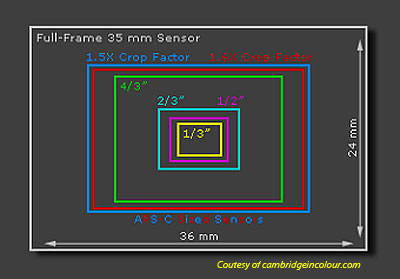
Most digital cameras today use a sensor closer to APS-C size. As a result, lenses mounted on APS-C DSLRs behave as if they are 150% to 200% longer than the marked focal length. Other Sony DSLR cameras, like the A700, also feature a 23.5x15.6mm APS-C sensor.
In the computer world, increasingly smaller traces mean higher density, more transistors, and generally better and faster performance. However, the digital sensor is not a digital device; it is an analog device that gathers light and turns it into a digital signal. Sensors are the reverse of digital electronics in that larger is almost always better in sensors, with everything else equal. More details on how digital sensors actually work can be found in The Digital Sensor.
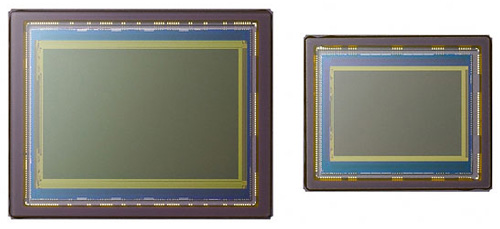
| DSLR Sensor Comparison | ||||
| Camera | Effective Sensor Resolution | Sensor Dimensions and Area |
% of Full-Frame | Sensor Density (MP/cm2) |
| Olympus E-520/E-3 | 10 | 13.5x18 2.43 cm2 |
28.10% | 4 |
| Canon XSi | 12.2 | 14.8x22.2 3.28 cm2 |
38.00% | 3.7 |
| Sony A350 | 14.2 | 15.8x23.6 3.72 cm2 |
42.90% | 3.8 |
| Pentax K20D | 14.6 | 15.6x23.4 3.65 cm2 |
42.20% | 4 |
| Canon 50D | 15.1 | 14.9x22.3 3.32 cm2 |
38.40% | 4.5 |
| Sony A700, Nikon D300, Nikon D90 | 12.3 | 15x23.5 3.66 cm2 |
42.40% | 3.3 |
| Nikon D700/Nikon D3 | 12.1 | 24x36 8.64 cm2 |
100% | 1.4 |
| Canon 5D | 12.7 | 24x36 8.64 cm2 |
100% | 1.5 |
| Canon 1Ds Mark III | 21.1 | 24x36 8.64 cm2 |
100% | 2.4 |
| Sony A900 | 24.6 | 24x35.9 8.61 cm2 |
100% | 2.9 |
The last column in the chart is the one that tells the story most accurately, however. Here the effective sensor resolution is divided by the sensor area to yield a sensor density. The lower the density, the larger the individual pixel size, and the more data that pixel can gather - all else being equal. There are a few surprises here, such as the Sony A350 being essentially the same density as the Canon XSi, and the new Canon 50D having the highest density of any current DSLR camera.
The last column does put into perspective the true potential of the full-frame sensor and shed some light on the true meaning of Sony's 24.6MP A900 sensor. At 2.9MP per cm2, the A900 still exhibits a lower density and theoretically better high ISO performance that any current APS-C DSLR. This is very much at odds with the ridiculous claims many on the web are making about Sony going too high in resolution on the A900. In fact, sensor density on the A900 is lower than the 10MP Canon 40D, which is 3.1.
The point is that any issues Sony may be found to have with noise are not the result of pixels being "too small". All else being equal the high ISO noise should be at least as good as an 8 to 10MP Canon sensor. Where the Sony does suffer is in comparison to sensor density of other full-frame sensors. In that metric the Sony has twice the pixels per cm2 of a Nikon D3/D700 and Canon 5D, and keeping up in high ISO performance with those cameras would be quite a feat.
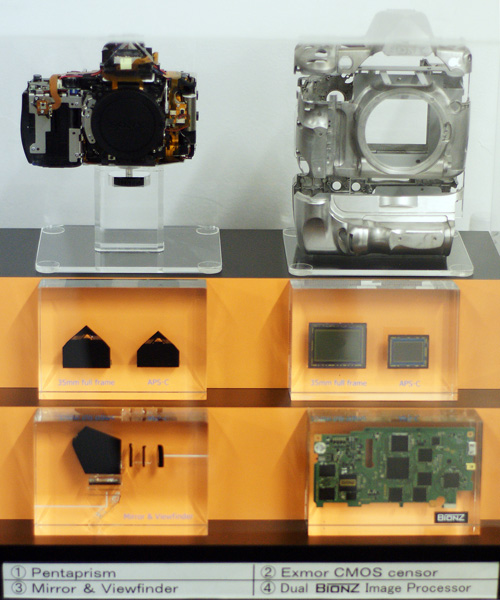
Moving a digital SLR camera to full-frame involves a lot more than just the sensor, however. Everything is bigger, heavier, and more difficult to accomplish. You can clearly see some of those challenges in this Sony case comparing sensors, pentaprisms, the microprocessor to move the huge increase in data (dual BIONZ), and the motors to control the in-camera image stabilization (IS). Rumors were rampant for months that Sony just could not get their signature SteadyShot IS to work in full-frame, which would have been a major failing had it turned out to be true. Now that we have used the A900 hands-on we can report that SteadyShot is definitely working as it should, and Sony still claims a 2.5 to 4.0 stop improvement in hand-holdability in the full-frame A900.
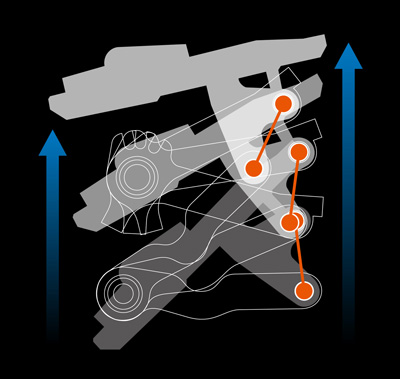
To accomplish this Sony employed a parallel-link to move instead of flip the mirror. This reduced vibration substantially to reduce the demands on SteadyShot. It also had the benefit of allowing a shorter front to back dimension while still utilizing a full-frame mirror.
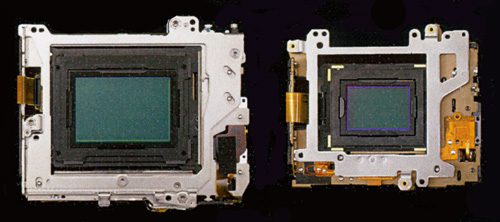
The second innovation was the sensor motors themselves. Since SteadyShot is controlling heavier components in even greater motion than APS-C, the motors required a 50% increase in output. Amazingly, the motors were beefed up, twice as many pixels are being captured and processed with dual BIONSZ processors, and with the same NP-FM5000H battery used in the A700, A350, A300, and A200 they extended the expected battery life in the A900 to 850 shots. Even if you're predisposed to hate Sony because you are a loyal Canon fan, you have to admire the engineering that went into solving many of these challenges.










53 Comments
View All Comments
chiew - Sunday, September 14, 2008 - link
If all you want is 24mp...Nikon's D700 is priced equivalently, doesn't have the 24mp...but it has more ISO range and a pro AF system. I don't see why you're crying.
Lord 666 - Friday, September 12, 2008 - link
More than likely same MP in sensor, but same or better outstanding ISO performance as D3.I've never held a Sony DSLR yet, but question the build quality. Additionally, I find it interesting that when other camera companies market their cameras, they almost always exclusively show the pics taken with them, but no cameras inside those pictures as subjects. Sony on the other hand releases pictures "in the wild" of people using the camera almost as models. Check out http://www.dailytech.com/article.aspx?newsid=12902">http://www.dailytech.com/article.aspx?newsid=12902
Wesley Fink - Friday, September 12, 2008 - link
Sony announced the A900 with both studio setups surrounded with 2x3 feet enlargements of images taken with the A900. The brochure for the A900 is around 8x12" and filled with double page photos(12x16 inches). Both studio setups were tethered to huge Bravia HD TVs. The photographers in both settings were shooting, displaying on screen and doing 6.5x zooms to show detail. A large number of A900 cameras were available for us to shoot both scenes.In the Sony A900 launch event the emphasis was clearly on images captured with the the A900. As for build quality you should examine an A900 to answer your questions about build quality. Feel and Build Quality certainly appear superb. I also own a D3 and D700 and the Sony A900 belongs in that league IMHO.
Lord 666 - Friday, September 12, 2008 - link
So you have finally come over to the Nikon side with those investments in the D3 and D700? Don't you also have/had a D300?Wesley Fink - Friday, September 12, 2008 - link
I sold my D300 and all my DX lenses when I went for the D3/D700, and I particularly like the size, capabilities. and value of the D700. I also own other cameras and have some lenses for every system we review since they are needed for testing.My main APS-C since the exit of the D300 is the Sony A700 which is the same sensor and LCD as the D300, but obviously not the same electronics/post processing as the Nikon. Sony has continued to improve their post-processing and finally have the option to turn off NR completely in RAW with firmware 4. JPEGs are also further improved in 4. THe A700 is very nice with the in-body IS that works with lenses like the Tamron 18-250mm (or Sony 18-250mm), which is a really terrific lens for when I need small and compact.
I am also testing a Sony A200 right now, which at less than $500 for camera with body IS and 18-70mm kit lens is looking like a heck of a buy.
davidaspart - Friday, September 12, 2008 - link
"Same Pricey Battery- The same proprietary NP-FM500H battery used in the A700, A350, A300, and A200 is also used in the A900. Great consistency, but you can still only buy it from Sony and you will still pay $55 to $95 for a spare. Sony insists on pimping their battery manufacturing even if their stubborn insistence on a proprietary battery drives some users away in a market where they need to win new users."Oh come on!
Thats like saying someone who buys a Ferrari worries that it takes premium fuel.
The camera costs $3000!
Koing - Friday, September 12, 2008 - link
Indeed. How much are OEM Canon cameras?If you drop $3000 on a camera and $500 on a flash $100 for a battery isn't a big deal...
The MS is a Sony thing...
Koing
Wesley Fink - Friday, September 12, 2008 - link
The less than $500 A200 kit uses the same battery as the A900, which is great consistency. Frankly so did the A100, but you could buy generic A100 batteries if you chose for less than $8. When Sony introduced the A700 they added a groove to the center of the battery so A100 batteries would no longer fit and apparently patent4ed the revised design. In fact A100 chargers still work just fine with the new Sony A700/A900/A350/A300/A200 battery.Many would definitely stick with the manufacturer's battery, but my complaint is about choice. I can choose which battery with Canon, Nikon, Pentax and Olympus batteries as generic options are readily available. You can not choose another battery with any of the new Sony cameras. Sony is a huge battery maker and they have locked up choice. You are forced to buy the Sony overpriced battery as there are no other choices in the market.
As an aside Sony STILL will not allow the use of AA batteries in their grips. Many like the versatility of using rechargeable AAs to power their grips instead and other companies include the AA insert or offer it as an option. There is also the issue of flexibility. If you get caught with a dead proprietary battery in the field it is reassuring to know you can continue shooting with AAs that are readily available anywhere - but that is not an option with Sony DSLR cameras.
KorruptioN - Friday, September 12, 2008 - link
I've mentioned this before - the battery incorporates InfoLithium technology which relays exact info in terms of a percentage remaining, instead of a graphic battery meter with five different levels. This feature is fantastic and is worth the money (to me).Serious question now, does Nikon's battery in the D300/D700/D3 relay that same percentage info even if you get a generic battery? I know that you have to dive deep into a menu to get that information.
Wesley Fink - Friday, September 12, 2008 - link
The D300/D700 use the same EN-EL3e battery as the D80, which does not provide a percentage. With optional accessories you can add the BL-4(a) high capcity battery to the MB-D10 battery grip and it does indeed report the percentage - at least when charging and on the D3. That battery though is 2500mAh and not the lower capacity 16500mAh of the Sony battery.Generics for the EN-EL3e used in the D700 and D300 generally perform the same and there are many with higher capacity and longer life. The EN-EL4(a) used in the D3 and D2x is tougher for finding generic replacements. Some I have seen do work but it is much more a question mark than the 3e and the generics generally don't report percent.
The Sony NP-FM500H charges just fine to 100% in the old chargers for the A100, but the groove prevents them fitting in any of this generation Sony cameras. The Info-Lithium is useful to me but it is not worth the 700% to 1200% premium to me that Sony charges for the FM500H compared the generics. I appreciate that it is worth it to you, but I would prefer to be able to use some of the 2000mAh batteries I used with the A100.